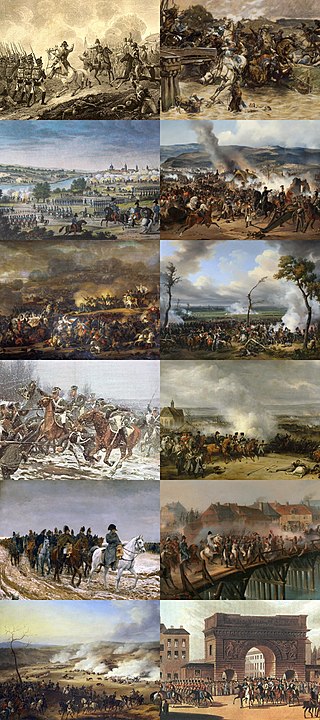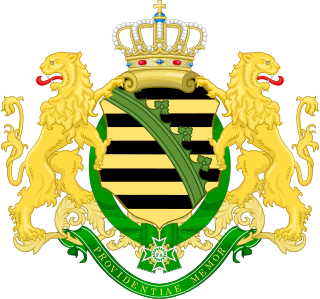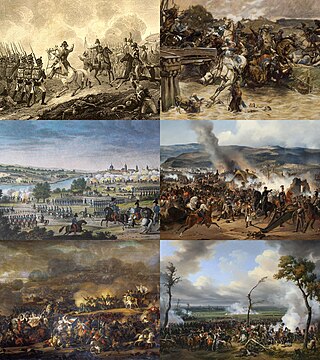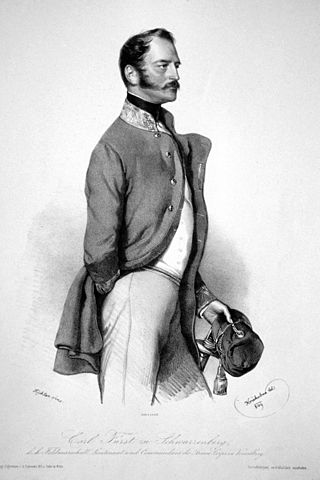
The Battle of Leipzig, also known as the Battle of the Nations, was fought from 16 to 19 October 1813 at Leipzig, Saxony. The Coalition armies of Austria, Prussia, Sweden, and Russia, led by Tsar Alexander I and Karl von Schwarzenberg, decisively defeated the Grande Armée of French Emperor Napoleon Bonaparte. Napoleon's army also contained Polish and Italian troops, as well as Germans from the Confederation of the Rhine. The battle was the culmination of the German Campaign of 1813 and involved 560,000 soldiers, 2,200 artillery pieces, the expenditure of 400,000 rounds of artillery ammunition, and 133,000 casualties, making it the largest battle of the Napoleonic Wars, and the largest battle in Europe prior to World War I.

The Battle of Dresden was a major engagement of the Napoleonic Wars. The battle took place around the city of Dresden in modern-day Germany. With the recent addition of Austria, the Sixth Coalition felt emboldened in their quest to expel the French from Central Europe. Despite being heavily outnumbered, French forces under Napoleon scored a victory against the Army of Bohemia led by Generalissimo Karl von Schwarzenberg. However, Napoleon's victory did not lead to the collapse of the coalition, and the weather and the uncommitted Russian reserves who formed an effective rear-guard precluded a major pursuit. Three days after the battle, the Allies surrounded and destroyed a French corps advancing into their line of withdrawal at the Battle of Kulm.

Johann Graf Radetzky von Radetz was a Czech nobleman and Austrian field marshal. He served as chief of the general staff in the Habsburg monarchy during the later period of the Napoleonic Wars and proved instrumental in the allied victory as one of the primary architects of the Trachenburg Plan and the Leipzig Campaign. Afterwards, he embarked on military reforms of the Austrian army. His reputation was one of discipline and fairness; he was revered by his troops among whom he was known as Vater ('Father') Radetzky. He is best known for the victories at the Battles of Custoza and Novara during the First Italian War of Independence. Johann Strauss I's Radetzky March was commissioned to commemorate Radetzky's victories at the Battle of Custoza.

In the War of the Sixth Coalition, sometimes known in Germany as the Wars of Liberation, a coalition of Austria, Prussia, Russia, Spain, Great Britain, Portugal, Sweden, Sardinia, and a number of German States defeated France and drove Napoleon into exile on Elba. After the disastrous French invasion of Russia of 1812 in which they had been forced to support France, Prussia and Austria joined Russia, the United Kingdom, Sweden, and Portugal, and the rebels in Spain who were already at war with France.

Friedrich Karl Ferdinand Freiherr von Müffling, nicknamed Weiss was a Prussian Generalfeldmarschall and military theorist. He served as Blücher's liaison officer in Wellington's headquarters during the Battle of Waterloo and was one of the organizers of the final victory over Napoleon. After the wars he served a diplomatic role at the Congress of Aix-la-Chappelle and was a major contributor to the development of the Prussian General Staff as Chief. Müffling also specialized in military topography and cartography.

The Military Order of Maria Theresa was the highest military honour of the Habsburg monarchy, Austrian Empire and Austro-Hungarian Empire.

Karl Philipp, Fürst zu Schwarzenberg was an Austrian Generalissimo and former Field Marshal. He first entered military service in 1788 and fought against the Turks. During the French Revolutionary War, he fought on the allied side against France and in that period rose through the ranks of the Imperial Army. During the Napoleonic Wars, he fought in the Battle of Wagram (1809), which the Austrians lost decisively against Napoleon. He had to fight for Napoleon in the Battle of Gorodechno (1812) against the Russians and won. During the War of the Sixth Coalition, he was in command of the allied army that decisively defeated Napoleon in the Battle of Leipzig (1813). He participated in the Battle of Paris (1814), which forced Napoleon to abdicate.

Vinzenz Ferrerius Friedrich Freiherr von Bianchi, Duke of Casalanza, was an Austrian Feldmarschallleutnant who notably served during the Napoleonic Wars.

The Royal Saxon Army was the military force of the Electorate (1682–1807) and later the Kingdom of Saxony (1807–1918). A regular Saxon army was first established in 1682 and it continued to exist until the abolition of the German monarchies in 1918. With the formation of the Confederation of the Rhine by Napoleon the Royal Saxon Army joined the French "Grande Armée" along with 37 other German states.

Ferdinand Karl Friedrich Freiherr von Wintzingerode was a German nobleman and officer in several different armies of the Napoleonic Wars, finally ending up as a general in the Imperial Russian Army and fighting in the War of the Sixth Coalition against the French invasion of Russia and the subsequent campaigns in Germany and France. He appears in Tolstoy's War and Peace.

Friedrich Karl Freiherr von Tettenborn was a famous cavalry commander in the Austrian and Russian armies during the Napoleonic Wars.

Louis Charles Folliot de Crenneville joined the French royal navy in the 1770s. During the French Revolution he abandoned the First French Republic and became an Émigré. Soon afterward, he tendered his services to Habsburg Austria. He earned promotion to general officer during the Napoleonic Wars and fought in all the major campaigns against his former country. He led a division during the War of the Sixth Coalition and remained in Austrian service until his death.

Heinrich Hermann Josef Freiherr von Heß, was an Austrian soldier and field marshal, who entered the army in 1805 and was soon employed as a staff officer on survey work.

The German campaign was fought in 1813. Members of the Sixth Coalition, including the German states of Austria and Prussia, plus Russia and Sweden, fought a series of battles in Germany against the French Emperor Napoleon, his marshals, and the armies of the Confederation of the Rhine - an alliance of most of the other German states - which ended the domination of the First French Empire.

Philip August Frederick was Landgrave of Hesse-Homburg from 19 January 1839 until his death. He was a field marshal in the imperial Austrian army.

Edmund Leopold Friedrich, Prince of Schwarzenberg was the last created Austrian field marshal of the 19th century.

Ignaz Franz Graf zu Hardegg auf Glatz und im Marchlande was an Austrian General of the cavalry. He was an important commander during the Napoleonic Wars and from 1831 to 1848 President of the Hofkriegsrat.
Demeter Freiherr Radossevich von Rados was an Austrian nobleman. and an imperial general during the Napoleonic Wars.

Karl II Prince of Schwarzenberg was an Imperial Austrian and Czech noble and Feldzeugmeister, who fought in the First Italian War of Independence. He was Governor of Transylvania between 1851 and 1858.
The Army of Bohemia was a coalition field army during the War of the Sixth Coalition in 1813–1814. It was under the command of the Austrian field marshal Karl Philipp zu Schwarzenberg. In addition to commanding the field army, Schwarzenberg was also the supreme allied commander and the commander of the Austrian army in Bohemia.


















